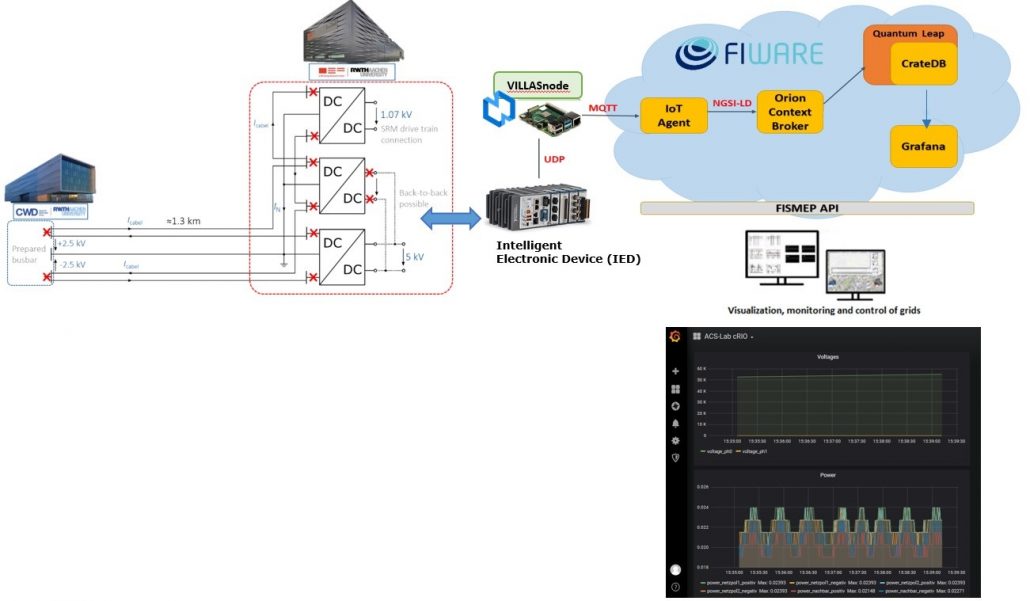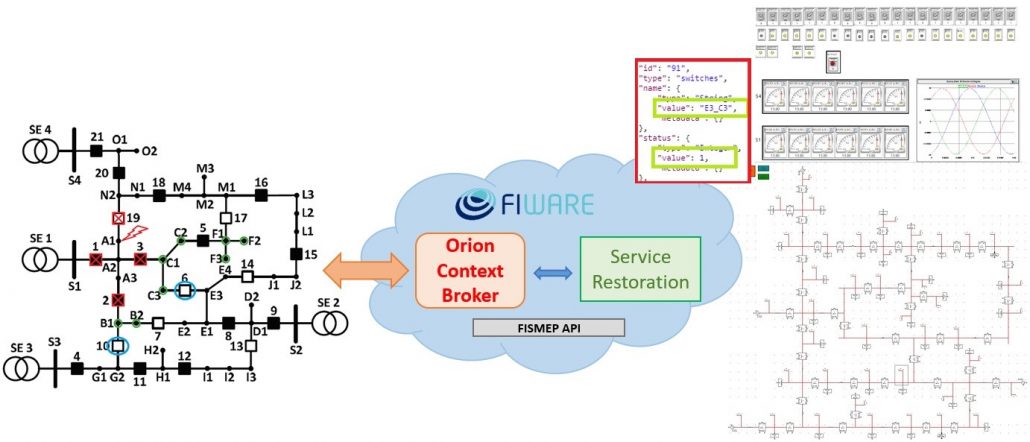Field Test Germany (WP4)
Innovative MV grid automation powered by FIWARE-based cloud platform
The main goal of the German field test is the virtualization of the automation architecture for distribution grids in the FISMEP cloud platform. Flexible Electrical Networks (FEN) GmbH and RWTH Aachen University developed an automation architecture based on FIWARE technology for the cloud virtualization of energy services in medium-voltage (MV) distribution grids. The activities focus on two use cases in particular: the monitoring and control of a MV grid with direct current (DC) Technology, and the automated fault management system for alternating current (AC) or hybrid AC-DC distribution grids.
The main contribution of FISMEP is the creation of a completely new distributed architecture that facilitates the implementation of the new energy services and scales up the system horizontally. Development of new standard interfaces for energy services is achieved by means of a multi-layered architecture. The first layer is the interface to the field: FISMEP includes a set of standard protocols and data management capabilities for mapping the raw data coming from a variety of sensors and standardized data representation in the cloud. The second layer is given by the combination of Generic Enablers (GEs), as provided by FIWARE, and a set of Domain Specific Enablers (DSEs), standard software services created in the context of FISMEP. The third layer is the open API, developed in FIWARE, offering easy data access to third parties that need to collaborate with the utility running in the platform.
The developed FISMEP energy platform has been integrated with the industrial field devices installed in the electrical grid to collect electrical measurements via standard communication protocols and provide control commands obtained by users’ settings and/or algorithms computations.
Monitoring and control of MVDC grid
The first use case utilizes the medium-voltage direct current (MVDC) grid on Campus Melaten of RWTH Aachen University, which has been commissioned in November 2019 by the Flexible Electrical Networks (FEN) Research Campus, along with affiliated RWTH institutes and industry partners. The multi-terminal grid is constituted by three DC-DC converters that connects different locations on campus with 5 km MV cables. The converters, with a power of up to 5 MW, are located in a unique switchgear that also hosts devices for protection, switching and measuring purposes. The measurement of electrical quantities in the MVDC network are provided by current and voltage sensors (transducers) installed on the busbars and by converters sensors. These electrical measurements are collected by Intelligent Electronic Devices (IEDs) that constitute the interface with the FISMEP platform. The main goal of data collection from the MVDC grid is the deployment of a supervisory control and data acquisition (SCADA) system, allowing the visualization, monitoring and control of the grid in real time.
Additionally, the use of time-series database permits the deployment of analysis about transitory events that occur in the network. These data constitute the basis for further energy services, which could be added in the FISMEP platform to improve the management of the MVDC research grid.

FIWARE framework is used as a central system to manage and store the data as this framework contains a list of open-source services to facilitate and accelerate development of smart internet-related application in various domains. The developed automation architecture relies on Context Broker (CB) Orion, the core Generic Enabler (GE) in the FIWARE catalogue. As current data are stored in CB Orion, but do not provide time related and historical information necessary for advanced applications, the software component CrateDB is implemented to stow electrical measurements from the grid. Moreover, FIWARE offers IoT Agent GE to establish communication among IoT devices and the cloud platform, based on predefined standard protocols; in the presented implementation, IoT Agent is used to interface the IEDs, installed in the electrical MV network, connected to transducers and converters sensors.
Virtualized Service Restoration of Distribution Grids
As a second use case, aiming at enhancing the self-healing capability of distribution grids in case of fault occurrence, a Service Restoration (SR) solution has been developed and implemented in the FISMEP platform. The SR is based on an innovative Rule-Based Optimization (RBO) algorithm, specifically developed as the first countermeasure in critical conditions, as High Impact Low Probability (HILP) events. The SR has been developed as middleware, hence it is independent of grid structure or specific electrical parameters. Moreover, it is integrated into the FISMEP platform with the FIWARE components to deploy an automated cloud-based SR. To test the SR, different MV AC and Hybrid AC-DC distribution grids, in several fault conditions, are emulated in the Real-Time Digital Simulator (RTDS). Through the Gigabit Transceiver Network (GTNET) card of RTDS the grid data could be sent/published into a communication network via its Ethernet port thus emulating the protection and metering devices.


